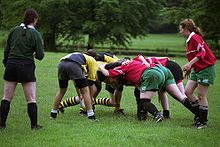Scrum (rugby)
The Arranged scrum (English scrum ) in different variants of the rugby the default situation, the game after minor infractions, a forward unauthorized play of the ball or after an off (only in the rugby league restart). The team that has not committed the rule violation receives a throw-in. The arranged scrum is more important and more frequent in rugby union . There is also the term open scramble (English ruck ), which is part of the open game. The crush is just as typical of this sport as the alley .
Arranged scrum in rugby union
An arranged scrum in rugby union consists of 16 players from both teams (usually the strikers) who line up and tie each other in three rows. In the first row on the outer ranks are the two pillars that hold the middle player, the hooker, between them. From behind, both second-row strikers clamp themselves in the second row and give the crowd an additional boost. In the last row there are three players, the two outer wingers and the so-called number eight . On the order of the referee, the first two rows are then bound. The head of the pillars and the hooker is always to the left of the head of the direct opponent. All players now push forward, again only on the order of the referee, in order to enable their hooker to push the ball thrown from the side of the scrum backwards with their feet. Here the ball is picked up again and an attack initiated.
Arranged scrum in 7-a-side rugby
In 7-a-side rugby , the scrum consists of only six people, two pillars on each side and the hooker in the middle. Otherwise, the same rules apply as in 15 rugby union.
Arranged scrum in rugby league
The arranged scrum in rugby league consists of 12 players and is structured like a rugby union scrum, but without the wingers. The scrum half throws the ball through the legs of the left pillar directly to its own third-row striker ( loose forward ) at the end of the scrum. From there the game is continued by pass or run.
The possession of the ball is practically uncontested, and the team that does not throw in wins the ball very rarely. Since pressing is no longer permitted for safety reasons, the main task of the scrum is to take the strikers out of play for the next move and so on to create more space for the back team. This makes the scrum in rugby league easier and less time-consuming.
Open crush
In rugby union sport and its variants (e.g. 7-a-side rugby), the ball is fought in an open scrum if the ball carrier has been brought to the ground by a tackle . The tackled player must let go of the ball and at least two players tie themselves above it (one for each team) and try to push the opponent away from the ball. A distinction must be made between the open scrum and the package (English maul ), in which the ball is carried by a player in the hand and thus, in some cases, considerable space can be gained by pushing the package forward. In an open scrum, players are only allowed to play the ball with their feet. Apart from the fact that the player lying on the ground can support with his hands and the scrum half is allowed to dig for the ball with his hands (that is, can take the ball out of the scrum).
Web links
- Sports Science: The Science of the Scrum , YouTube video 5:39 min, uploaded on December 2, 2009, accessed on February 10, 2013.


